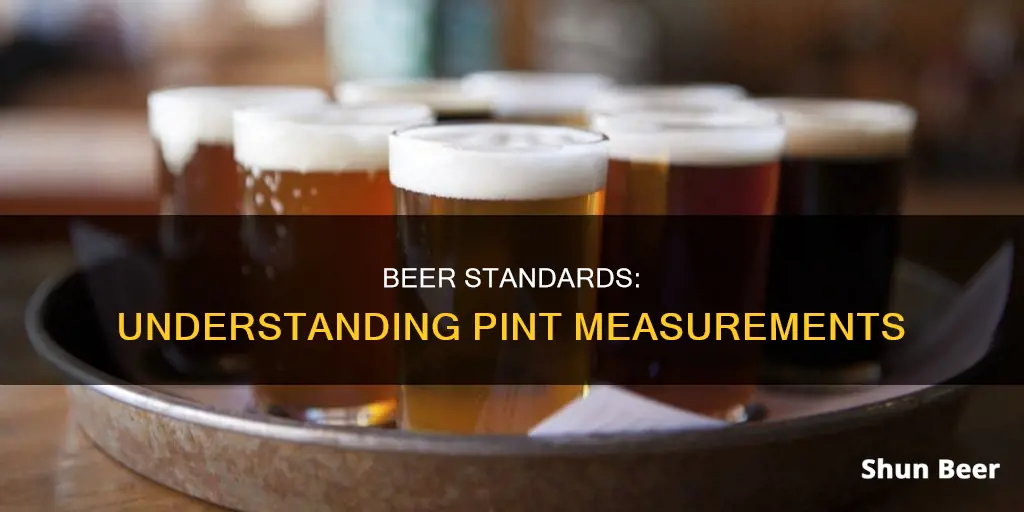
The standard size of a beer serving varies depending on where you are in the world. In the US, a pint of beer is 16 fluid ounces (473 millilitres), while in the UK, a pint is 20 fluid ounces (568 millilitres). In Australia, a pint is 474 millilitres, or 568 millilitres in South Australia. The standard serving size of beer in the US is 12 fluid ounces, which is roughly 355 millilitres. This means that a pint of beer in the US contains approximately 1.33 standard servings. However, it's important to note that the alcohol content of beer can vary, so the number of standard servings in a pint may differ.
| Characteristics | Values |
|---|---|
| US fluid pint | 16 ounces |
| Standard beer servings | 12-ounce cans or bottles |
| Beer range in establishments | 12 to 16 ounces |
| US pint of beer | 16 fluid ounces |
| UK imperial pint | 20 fluid ounces (568 ml) |
| Australian 'Pint' | 474 ml or 568 ml in South Australia |
| Canadian pint | 473 ml |
| Standard beer serving size in the US | 12 fluid ounces |
| US pint | 1.33 standard beers |
| Lager ABV | 4-6% |
| IPA ABV | 7-10% |
| Standard drink | 12 ounces of beer |
What You'll Learn

A US pint is 16 fluid ounces
In the United States, a pint of beer is defined as 16 US fluid ounces, or 473 milliliters. This is in contrast to the British imperial pint, which is about 20% larger at 20 imperial fluid ounces or 568 milliliters. The difference in volume between the two systems is due to their distinct historical origins.
The US liquid pint is derived from the country's customary measurement system, which was established in the formative years of the nation. On the other hand, the imperial system, used in the United Kingdom and formerly throughout the British Empire, was instituted in 1824. While both systems are rooted in English units, they have evolved independently over time.
The US fluid ounce, originally defined as the volume occupied by an ounce of wine, is larger than the Imperial fluid ounce due to the lower density of alcohol compared to water. In contrast, the Imperial fluid ounce was defined as the volume of an ounce of water. This distinction further contributes to the discrepancy in pint sizes between the two systems.
The US pint, at 16 fluid ounces, is widely recognized as the standard for serving beer in bars and restaurants across the country. However, it's worth noting that serving sizes can vary, and different establishments may offer beers in volumes ranging from 12 to 16 ounces. This flexibility in serving sizes allows for a diverse range of beer options, catering to various consumer preferences and tastes.
Understanding the measurements and serving sizes of beer is not only essential for responsible drinking but also for ensuring an enjoyable drinking experience. The variance in serving sizes and beer types highlights the importance of making informed choices when consuming alcoholic beverages.
Barrel of Beer, Pints Galore: How Many?
You may want to see also

A UK pint is 20 fluid ounces
The UK pint is about 20% larger than the American pint, which is 16 fluid ounces or 473 millilitres. This difference in volume between the two types of pints can be attributed to their distinct definitions in the imperial and United States customary measurement systems.
In the UK, the imperial pint is the standard unit of measurement for draught beer and cider, as well as for milk in returnable containers. By law, draught beer and cider must be sold in a third of a pint, two-thirds of a pint, or multiples of half a pint, served in certified, stamped, measured glasses or from government-stamped meters.
The price of a pint in the UK varies depending on the region, with the most expensive pints found in London, averaging £5.59 for a lager. In contrast, the North East offers the cheapest pints, with an average lager costing £4.56. The average price of a pint in the UK has been rising, currently sitting at £4.79, a nearly 30% increase since before the COVID-19 pandemic.
Exploring Beer and Liquor: What Sets Them Apart?
You may want to see also

A pint is a unit of volume
In the United States, two kinds of pints are used: a liquid pint, also known as a US fluid pint, and a less common dry pint. The liquid pint is equal to 16 US fluid ounces (473 millilitres) and the dry pint is equal to 551 millilitres. The liquid pint is the standard when it comes to beer in the US.
The imperial pint, used in the United Kingdom and Ireland, is equal to 20 imperial fluid ounces (568 millilitres). It is also used to a limited extent in Commonwealth nations. In the US, this would be equivalent to about 1.25 liquid pints.
In addition to regional variations, the volume of a pint can also vary based on the substance being measured. For example, historically, a "pint" of wine was different from a "pint" of beer or milk.
While almost all other countries have standardised the metric system, some nations retain traditional units called pints, particularly for beverages. For example, in Australia, a "pint" of beer is 425 millilitres in South Australia, but 570 millilitres in other states.
Explore Lager and Helles Beer: Styles, Taste, and Origins
You may want to see also

A pint of strong lager contains 3 units of alcohol
The number of units in a drink depends on its size and its alcohol strength. For example, a pint of lager is typically around 568ml, and its ABV (alcohol by volume) is usually between 3.5% and 5.5%. To calculate the number of units in a pint of lager, you can use the following formula:
ABV x volume (in ml) ÷ 1,000 = units
So, for a pint of lager with an ABV of 5%, the calculation would be:
5% x 568ml ÷ 1,000 = 2.84 units
This is just under 3 units of alcohol.
It's important to keep track of how much alcohol you're consuming, as it can affect your health and your ability to perform tasks like driving. The UK government recommends that men and women should not drink more than 14 units of alcohol per week. This should be spread over 3 or more days and include several alcohol-free days.
Stroh's Beer: Unique Characteristics and Distinctions
You may want to see also

A pint glass is typically conical or nonic in shape
A pint glass is a form of drinkware that typically holds either a British imperial pint of 20 imperial fluid ounces (568 ml) or an American pint of 16 US fluid ounces (473 ml). The shape of a pint glass is typically conical or nonic.
A conical pint glass, also known as a "sleever" or “shaker pint" in the US, is shaped as an inverted truncated cone, usually around 6 inches (15 cm) tall, and tapers by about 1 inch (25 mm) in diameter. The conical pint glass is the more common shape in the US, holding 16 US fl oz (473 ml) to the rim.
A nonic pint glass, pronounced "no-nick", is a variation on the conical design, featuring a bulge a couple of inches from the top. This design was invented by Hugo Pick of Albert Pick & Co. and was commercialised as "Nonik" to prevent the glass from chipping or "nicking". The nonic design also improves grip, prevents glasses from sticking together when stacked, and reduces breakage when stacked or tipped over. The nonic glass is standard in British pubs, where it is valued for its durability and utility.
Beer Nuts vs Deer: What's the Difference?
You may want to see also
Frequently asked questions
A US pint of beer is 16 fluid ounces, and the standard serving size in the US is 12 fluid ounces. Therefore, a pint contains approximately 1.33 standard beers.
A US pint of beer is equivalent to 473 milliliters.
In the US, the standard beer serving size is 12 ounces, but it can vary between 12 and 16 ounces depending on the establishment.
The number of beers in a pint depends on the type of beer. Lighter ales and lagers have lower alcohol content, allowing for more beers in a pint. Beers with higher alcohol content, like pale ales and pilsners, contribute fewer beers to a pint.
The volume of a pint varies across the world. For example, a British imperial pint is 20 fluid ounces (568 ml), while a South Australian pint is 425 ml or 474 ml.







